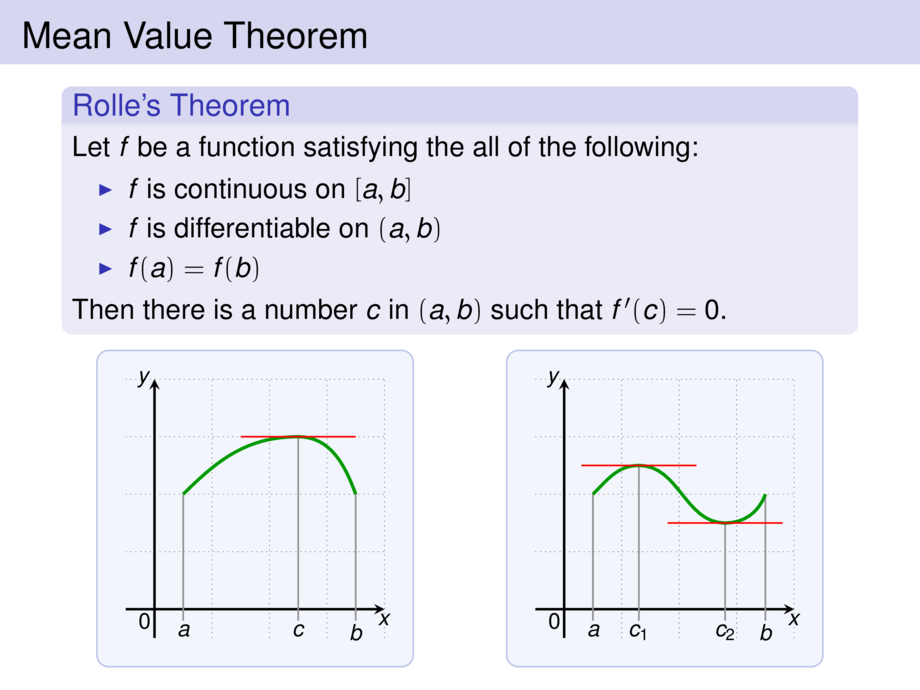



































































































2/66
\begin{frame}
\frametitle{Mean Value Theorem}
\rolle
\only<1>{
\begin{center}
\scalebox{.8}{
\begin{tikzpicture}[default,baseline=1cm]
\diagram{-.5}{4}{-.5}{4}{1}
\diagramannotatez
\draw[gray] (.5,2) -- node [black,at end,below] {$a$} (.5,-.2);
\draw[gray] (3.5,2) -- node [black,at end,below] {$b$} (3.5,-.2);
\draw[gray] (2.5,3) -- node [black,at end,below] {$c$} (2.5,-.2);
\begin{scope}[ultra thick]
\draw[cgreen,ultra thick] (.5,2) to[out=45,in=180] (2.5,3) to[out=0,in=110] (3.5,2);
\end{scope}
\node (a) at (2.5,3) {};
\draw[cred] ($(a)+(-1,0)$) -- +(2,0);
\end{tikzpicture}
}\hspace{1cm}
\scalebox{.8}{
\begin{tikzpicture}[default,baseline=1cm]
\diagram{-.5}{4}{-.5}{4}{1}
\diagramannotatez
\draw[gray] (.5,2) -- node [black,at end,below] {$a$} (.5,-.2);
\draw[gray] (3.5,2) -- node [black,at end,below] {$b$} (3.5,-.2);
\draw[gray] (1.3,2.5) -- node [black,at end,below] {$c_1$} (1.3,-.2);
\draw[gray] (2.8,1.5) -- node [black,at end,below] {$c_2$} (2.8,-.2);
\begin{scope}[ultra thick]
\draw[cgreen,ultra thick] (.5,2) to[out=45,in=180] (1.3,2.5) to[out=0,in=180] (2.8,1.5) to[out=0,in=-110] (3.5,2);
\end{scope}
\node (a) at (1.3,2.5) {};
\draw[cred] ($(a)+(-1,0)$) -- +(2,0);
\node (a) at (2.8,1.5) {};
\draw[cred] ($(a)+(-1,0)$) -- +(2,0);
\end{tikzpicture}
}
\end{center}
}
\pause
\begin{proof}
\begin{itemize}
\pause
\item If $f$ is constant\pause, then $f'(c) = 0$ for all $c$ in $(a,b)$.
\pause
\item If $f$ is not constant\pause, then there is $x$ in $(a,b)$
such that \vspace{-1ex}
\begin{talign}
f(x) > f(a) &&\text{ or }&& f(x) < f(a)
\end{talign}
\pause
Assume $f(x) > f(a)$. \pause
By the Extreme Value Theorem there is a $c$ in $[a,b]$ such that $f(c)$ is
the absolute maximum.
\pause\medskip
Then $c$ must be in $(a,b)$ and hence is a local maximum. \pause
Hence $f'(c) = 0$ by Fermat's Theorem.\vspace{-3.8ex}
\end{itemize}
\end{proof}
\vspace{10cm}
\end{frame}

